ZHCSIK0A July 2018 – October 2021 TPS3430
PRODUCTION DATA
- 1 特性
- 2 应用
- 3 说明
- 4 Revision History
- 5 Pin Configuration and Functions
- 6 Specifications
- 7 Detailed Description
- 8 Application and Implementation
- 9 Power Supply Recommendations
- 10Layout
- 11Device and Documentation Support
- 12Mechanical, Packaging, and Orderable Information
8.1.1 CRST Delay
The TPS3430 features three options for setting the reset delay (tRST): connecting a capacitor to the CRST pin, connecting a pull-up resistor to VDD, and leaving the CRST pin unconnected. Figure 8-1 shows a schematic drawing of all three options. To determine which option is connected to the CRST pin, an internal state machine controls the internal pulldown device and measures the pin voltage. This sequence of events takes 381 μs (tINIT) to determine which timing option is used. Every time WDO is asserted, the state machine determines what is connected to the pin.
 Figure 8-1 CRST Charging Circuit
Figure 8-1 CRST Charging Circuit